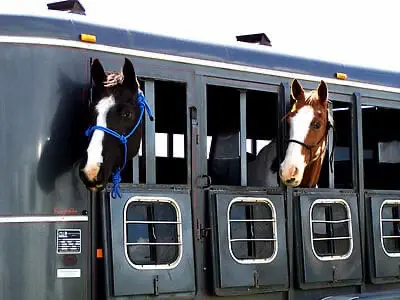Transporting a horse overseas can be a complex and costly process, but with the right planning, it can be done smoothly and safely.
Whether you’re moving for a competition, breeding, or relocation, the best way to transport your horse overseas involves careful consideration of several factors, including safety, comfort, logistics, and regulations. Here’s a detailed guide on the best way to transport your horse abroad.
1. Choose a Reputable International Horse Transport Service
The most reliable and safest way to transport a horse overseas is by using a professional international horse transport company. These companies specialize in handling the logistics of horse transport, ensuring that your horse is safely taken care of throughout the journey.
Why Choose a Professional Transport Service?
- Expertise and Experience: International horse transport services are experienced in navigating the complex regulations, health certifications, and customs procedures required for traveling internationally.
- Safety and Comfort: These companies use specialized horse containers (known as “horse stalls” or “horse boxes”) that ensure the horse is comfortable and secure during transit.
- Door-to-Door Service: Many services offer door-to-door transport, meaning they will pick up your horse from your farm or stable and deliver it directly to the destination.
Some well-known international horse transport companies include:
- Peden Bloodstock
- Toll Group
- DHL Animal Logistics
Before choosing a transport company, ensure that they are experienced in the specific destination country you’re traveling to, as regulations may vary from region to region.
2. Understand the Travel Method: Air Transport
The most common and efficient method for transporting horses overseas is by air, especially for long-distance travel. Air transport is fast, and many international horse transport companies use specially designed horse trailers for air travel.
A. Air Transport Process:
- Horse Stalls: Horses are typically transported in individual stalls within a specially designed cargo hold of the airplane. These stalls are spacious and well-ventilated, with bedding (like straw or wood shavings) to keep your horse comfortable.
- Quarantine: Depending on the destination country, your horse may be required to go through a quarantine period upon arrival. This is common when traveling internationally and ensures that the horse is free from diseases that could affect the local animal population.
- Sedation: While some horses travel well without sedation, others may require light sedation to keep them calm during the flight. This is something the transport company will help decide based on the horse’s temperament.
B. Air Travel Considerations:
- Duration of Flight: Air transport is generally the quickest option, with flight durations ranging from 6 to 20 hours, depending on the origin and destination.
- Climate Control: The cargo hold is typically temperature-controlled, but you’ll want to ensure that the horse has access to water and is as comfortable as possible during the flight.
3. Prepare Your Horse for Travel
Before the transport, it’s essential to prepare your horse to minimize stress and ensure a smooth journey. Here are some things you’ll need to do:
A. Health Certifications and Vaccinations:
- Veterinary Exam: Your horse will need to undergo a veterinary examination to ensure they are healthy enough for travel. The vet will also issue a health certificate stating that the horse is fit for transport.
- Vaccinations: Make sure that your horse is up to date on vaccinations. Many countries require specific vaccinations (such as rabies) before entering.
- Coggins Test: A negative Coggins test, which screens for equine infectious anemia, is often required for international travel.
B. Quarantine Requirements:
- Different countries have different quarantine requirements, and some may ask your horse to remain in quarantine for a certain period before or after the journey. Be sure to check the regulations of the destination country well in advance.
- Documentation: Ensure you have all the required documentation, including health certificates, import permits, and proof of vaccinations.
4. Arrangements for Stabling and Care Upon Arrival
Once your horse reaches its destination, you will need to make arrangements for stabling and care. This can involve:
- Quarantine Stables: If the horse needs to go through a quarantine process upon arrival, they will typically be housed in special facilities. Your transport company can help arrange this.
- Destination Stables: If you are relocating your horse to a specific stable or farm, ensure that accommodations are ready for your horse. Some horse transport companies offer additional services to help with stabling and settling your horse in.
5. Cost of International Horse Transport
The cost of transporting a horse overseas can vary widely depending on the destination, the distance, and the service provider. On average, transporting a horse by air can cost anywhere from $4,000 to $10,000 or more, including the following expenses:
- Transport Fees: The cost of the flight and the transport service, including airport handling and ground transport.
- Health Certificates and Vet Checks: Fees for veterinary exams, health certificates, and necessary vaccinations.
- Quarantine and Stabling Fees: Depending on the country, there may be additional fees for quarantine and stabling upon arrival.
- Insurance: Travel insurance for your horse is highly recommended, and this can cost an additional $100 to $500 or more depending on the coverage.
6. Alternative Methods of Transport
While air transport is the most common method, other options may be suitable depending on the circumstances:
A. Sea Transport:
- Boat or Ship: For certain routes, especially from the U.S. to Europe, transporting horses by sea can be an option. However, this method is generally slower and less commonly used. Horses are transported in specially designed stalls within the ship’s cargo hold.
- Duration: Sea travel takes significantly longer than air travel (usually 10 to 20 days), so this method is only ideal for specific circumstances.
B. Land Transport:
- In some cases, horses may be transported by land to a shipping port or directly to the destination, though this method is limited to countries with land connections. Land transport is typically used for shorter distances and will involve the use of specialized horse trailers.
Final Thoughts
The best way to transport a horse overseas is through a reputable international transport company that specializes in horse travel. Air transport is the most common and fastest method, but proper preparation, health checks, and attention to quarantine and documentation requirements are essential for a smooth journey. Depending on the destination, the transport process may be expensive, but it ensures your horse’s safety and comfort.
Be sure to plan well in advance, consult with professionals, and ensure that your horse is properly prepared for the journey to make the experience as stress-free as possible for both you and your horse.




